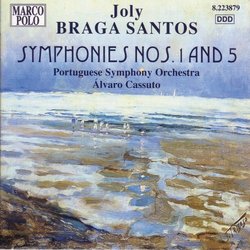Intriguing Portuguese master
V. Wilson | Cambridge, MA United States | 04/21/2000
(4 out of 5 stars)
"Joly Braga Santos' is a composer who ought to be heard and this disc gives an indication of why. Both pieces here are well-constructed and full of interesting music even if they are very different. Like the other Marco Polo disc with the Third and Sixth symphonies, this one combines a memorable, late Romantic effort with a tougher, much more modern piece. Santos' 1st Symphony, written in memory of those who died during WW II, is heavily influenced by Vaughan Williams-like modality. It has some of the toughness of that composer's 4th symphony, but is more appealing melodically and serves as a fitting testament. It's not as memorable as Santos' 3rd symphony, however.The 5th symphony is much more modern, with many edgy string effects, but the composer's personality does show through. Best is the second movement, with its kaleidoscopic marimba effects derived from the music of Mozambique. There's plenty of good music here, but it won't be played as often as the 1st.Overall, if you can only get one Braga Santos' disc, get the one with the 3rd symphony. If you like that, you'll like this one. And, hopefully, Marco Polo will favor us with the 2nd & 4th symphonies, both supposedly cut from the same fabric as 3!"
Not the place to start exploring the composer, but a rewardi
G.D. | Norway | 12/30/2009
(4 out of 5 stars)
"Of the six symphonies composed by Joly Braga Santos (1924-1988) the first four were relatively early, written in a colorfully tonal style slightly redolent of Vaughan Williams, Tubin, Sauguet, Respighi and Sibelius (among others), but still rather strikingly personal and with an unmistakable voice, culminating in the masterpiece that is the fourth symphony. The last two symphonies are much later and employ a very different language: modernist and far more "difficult", but still strikingly colorful and personal. There is thus a huge stylistic leap between the two works recorded here.
The first symphony is very much in the vein of Vaughan Williams, at least harmonically. It is an energetic, rhythmically vibrant work that makes a strong first impression. It is not, however, on the level of the subsequent symphonies and anyone coming to this one before the fourth, say, will have a hard time understanding what all the fuss is about. It is structurally weaker, the thematic material less memorable and the developments much less assured. Nevertheless it is an attractive, effective work worth hearing at least a couple of times - if the subsequent three symphonies hadn't existed as comparisons I think I would have sounded far less lukewarm.
The fifth dates from 1965-66 and is a rugged, harmonically rather dense work; rather forbidding the first time around, and full of unease and flickering shadows. It employs a large percussion section and incorporate influences from Mozambican popular music, but they are used in a strident and uncomfortable manner, with thumping drums and flaring brass amidst string textures that reminds me of old steam engines letting out puffs of vapor dissolving against the troubled, overcast night sky. The last movement opens with music of intense action that gradually develops into something more reflective and introvert. Overall it is by no means an easy work, but I found it ultimately quite rewarding and well worth spending some time and effort with.
To sum up, I would recommend against starting your exploration of the composer here (the fourth symphony is the one to go for in that respect), but there is still plenty to enjoy on this disc. The performances are enthusiastic and spirited and the sound quality is more than acceptable."


 Track Listings (7) - Disc #1
Track Listings (7) - Disc #1